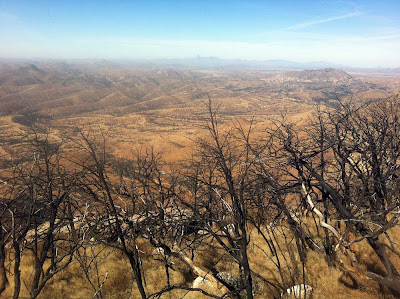If anyone has the gumption to check out a seldom birded sector of the AZAH circle in advance of the Dec 22 CBC, please consider scouting Area 1 – Bear Grass Tank. It's a huge area, but birders have only covered the western half, where there is better access and more habitat diversity. It wasn't covered at all last year, due to shortage of participants, so it's possible not a single birder has been there since the Dec 31, 2010 CBC.
This is one of the few areas that has a chance for Abert's Towhee, Chihuahuan Raven, Scaled Quail, and – if there's water – a good selection of ducks and maybe a rare water bird. On our first scouting trip here in 2008 we found an Eastern Phoebe in the good riparian vegetation below the dam. The northern, lower elevation parts of the area should help boost our Rufous-winged Sparrow numbers, and in the southern parts of the area are the right kind of juniper woodlands that could host Western Scrub-Jay, Townsend's Solitaire, and Western or Mountain Bluebirds.
As compilers, Jake Mohlmann and I have the luxury of deciding where WE want to bird most on the count day. And every time we start talking about the virtues of any individual area of the circle, we start yearning to cover that area ourselves. It turns out there is no bum area here. All have little pockets of habitat, endless off-trail hiking possibilities, side canyons that have never been birded.
How many people we send into this area really does depend on the water situation, so if you do go birding here in the next 4 weeks or so, let us know what you find. A high clearance vehicle is recommended, and directions are on the map below.
~ Rich Hoyer
Two miles north of Arivaca, turn east onto Universal Ranch Road (right at mile marker 2). From here the road jogs south, then east, then makes a few dog legs to go around the north then east side of Twin Peaks. Note: this road is not on the 1981 7.5-minute topo map.






